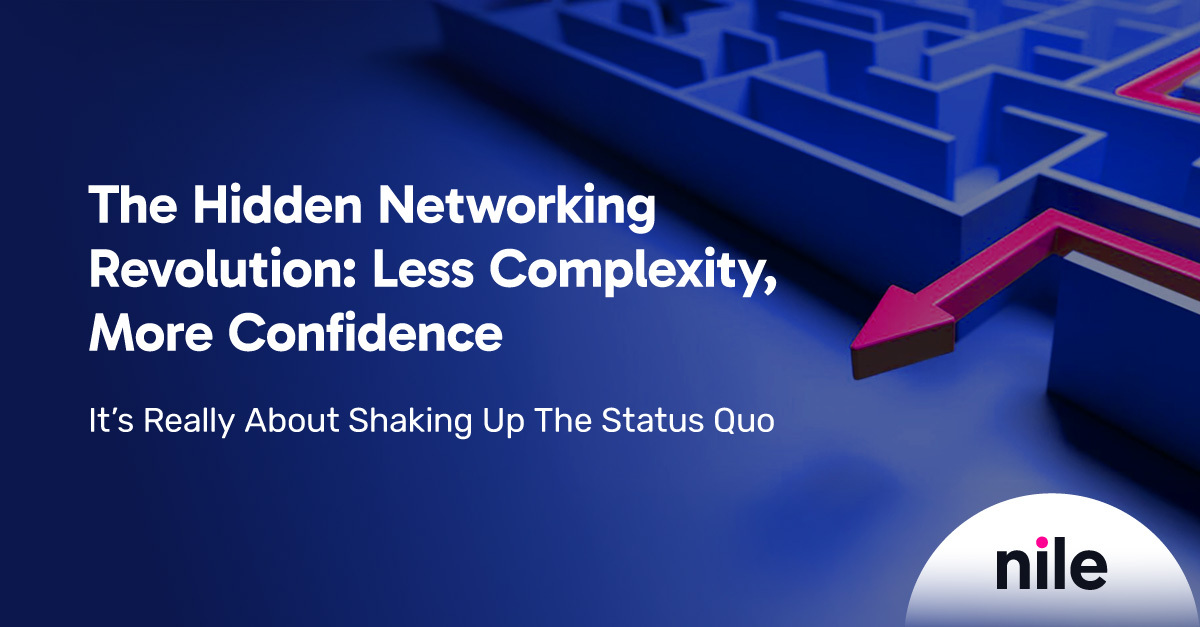Share Via
After years of dealing with the realities of traditional enterprise networks, I thought I’d seen it all: the patch cycles, the late-night ACL changes, the quiet heroics that keep everything running. Then I joined Nile as a Solutions Architect in the Pacific Northwest, and it reshaped my perspective on stability itself. For the first time, I saw what happens when a network stops demanding attention and quietly takes care of itself. The hardest part hasn’t been learning something new; it’s been unlearning what “normal” used to mean.
That understanding came back to me during a conversation with a university’s network team, the kind that quietly keeps hundreds of classrooms, dorms, and labs running without recognition. When I asked how long it usually took to push a new policy across campus, the lead engineer smiled and said, “About a week… if we’re lucky.” Then he added, half-joking, “And that’s assuming nothing breaks halfway.”
It was an honest, familiar kind of humor, the kind that comes from experience. These teams aren’t careless; they’re careful to a fault, managing decades of accumulated complexity with precision and patience. One wrong command, and a lecture hall loses Wi-Fi, a dorm goes dark, or a research lab freezes mid-experiment. Over time, that vigilance becomes a survival skill. “Grin and bear it” isn’t just a phrase; it’s muscle memory.
As a solutions architect working with customers across industries, I see the same pattern repeat itself: brilliant teams doing everything right yet quietly battling architectures that resist change. Even our partners echo it: some spend their days keeping complex infrastructures alive, while others return after years of deployments that limped along, determined to rebuild them right.
Beneath polished dashboards and layers of automation, most enterprise networks remain stitched together by years of quick fixes and technical debt. Each patch adds weight until stability feels fragile. Complexity has quietly become the biggest security risk of them all.
One retail customer said it best: “Our stores run smoother when we don’t touch the network.” Different industry, same truth: the fear of change has become the new definition of stability.
With network standardization comes a different mindset. By shifting to a secure enterprise network-as-a-service (NaaS) model built on a redesigned architecture, Nile is challenging the old equation. It’s not about selling boxes, licenses, or endless support contracts; it’s about delivering outcomes. The network is no longer something you constantly patch and monitor; it’s something that quietly takes care of itself, predictable, secure, and reliable by design.
At first, the idea feels unnatural. Engineers are wired to control everything, every VLAN, ACL, and software knob. But watching customers embrace a standardized model has been eye-opening. They stop asking about configurations and start asking about guarantees. They stop thinking in VLANs and start thinking in value.
The breakthrough is realizing what standardization really delivers: consistency. Every site, every building, every deployment works the same way. Software configuration happens automatically, and the risks that used to keep teams awake, VLAN loops, ACL drift, and roaming gaps simply disappear. The network just works.
In traditional environments, when complexity grows unbearable, the reflex is to offload it to the cloud, to automation, to someone else’s platform. But if the foundation is messy, the cloud just synchronizes that mess faster. I’ve seen enterprises spend months integrating new tools only to discover their legacy core still can’t tell a thermostat from a tablet.
That’s where Nile’s approach and Access Service stand apart. The architecture was built to natively leverage the cloud securely, intentionally, and without unnecessary complexity. Services like Guest Access and RADIUS are part of the foundation, not afterthoughts. And as one of my customers said recently, the real goal isn’t to manage the network better; it’s to reach a point where it manages itself.
The work I did before was meaningful, but exhausting; every feature solved a problem worth fixing, until the fixes themselves became the problem. It gave me a firsthand appreciation for how fragile “stable” networks can really be, and that perspective now shapes how I think about modernization.
There’s a better way to build and operate networks, one that starts with an open mind. Standardization isn’t a limitation; it’s what makes everything else possible. When the foundation is consistent, Zero Trust becomes simpler, visibility becomes effortless, and IT finally gets to focus on innovation instead of endless maintenance. The real progress begins when the network stops demanding attention and starts giving it back.
In my next piece, I’ll take a closer look at what this shift really enables: the tangible value of a standardized architecture, how Zero Trust becomes simpler when it’s built in from the start, and how IT teams regain the bandwidth to focus on innovation instead of maintenance.
To learn more:


